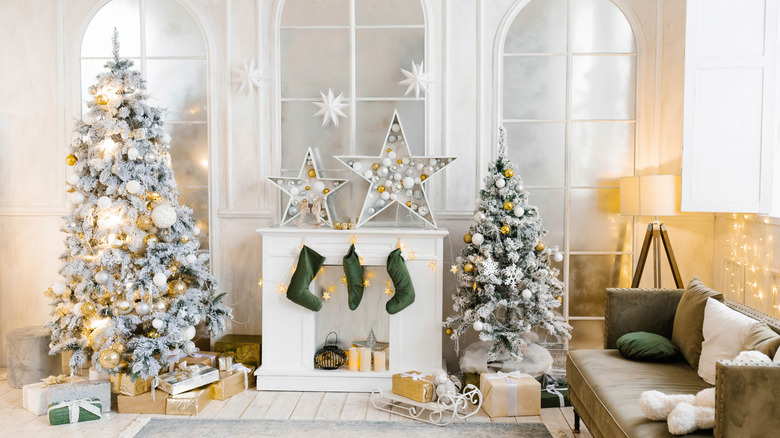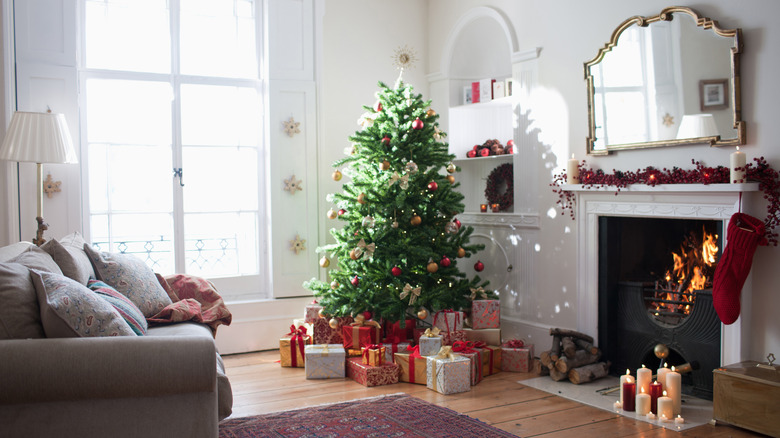Design
Natalie Francisco
Are you always sure when to stop adding ornaments to the Christmas tree? Or do you never have enough to fill it? These are two common problems when decorating for the holidays. Before deciding how to decorate your tree, it’s important to pick the right one for your home. Depending on available space, you may need a shorter or thinner tree and then decide whether to buy a real or fake version.
Of course, both types have their benefits and drawbacks, explains Greenpeace. Using a real Christmas tree means chopping one down and displacing wildlife. They also must be cared for daily by ensuring the stand is full of water. And when these trees start to dry out, they become a huge fire hazard in your home. However, they’re beneficial because once Christmas is over, you can dispose of them and the tree will decompose.
Conversely, the problem with a fake tree is that it will last forever. They’re made of PVC, a plastic known for pollution. To make an artificial tree worthwhile, it’s best to reuse it for about 20 years. However, when disposing of it, the plastic will continue to live forever in a landfill. If you know you won’t be able to care for a tree during the holidays and plan to reuse it, a fake tree may be the better choice. Once you have your tree, it’s time to start planning how to decorate it.
Beware of over-decorating

Chamomile_Olya/Shutterstock
Sometimes people get carried away when adding ornaments to their trees. If you’re not careful, you can accidentally over-decorate to the point that your shrub is hidden behind all the Christmas lights and bows. Luckily, if you’re known for adding too much, there are tips you can follow to keep the design balanced. According to Coulter’s Furniture, ensuring all your décor is evenly distributed is the No. 1 way to prevent over-decorating. In particular, you should be able to see your tree in the space between ornaments and lights.
One way to prevent overlapping these components is to decorate your tree with the Christmas lights off. Because our eyes are naturally drawn to light, you’re more likely to place the ornaments near the lights if they’re turned on. Instead, focus on any large empty spots and put your decorations there. The color of your Christmas tree can also cause it to look over-decorated. Unique colored trees have become popular, but they are a trend. If you’re tempted to purchase something pink or silver, consider using your usual green pine or fir and changing all your ornaments. They’re easy to swap out according to your style, so you’re not stuck with a different colored tree you don’t like next year.
Don’t under-decorate

Tom Merton/Getty Images
Under-decorating is another problem that comes with setting up Christmas trees, and doing this can leave them looking empty and unfinished. Bottom line: Have at least two components to decorate your tree, Christmas lights, and ornaments. Depending on your style, you can also use garland, bows, candy canes, or homemade nostalgic ornaments. The trick to making your tree look full is how you place these decorations.
Balsam Hill explains that you should decorate it in sections, working from the top to the middle and then to the bottom. However, the one exception to this rule is when you’re putting on the lights. They should go on first, and you should go around the tree, from the bottom to the top. To keep them in place, weave them between the branches. Then, you can move on to the ornaments. Using multiple sizes will create dimension, so your tree doesn’t feel flat. Larger ornaments should be tucked deeper into the tree, while the smaller ones go at the tips of branches. Then, you can use bows or garlands since they’re good for adding texture.




